Many teams are most afraid of two things when choosing a chain: sudden spikes in costs and confirmation times that fluctuate unpredictably. Caldera's recent upgrade is precisely aimed at 'nailing these uncertainties to the wall.' Three things are worth highlighting.
The first is the integration of EigenDA V2. The external metric is a data availability throughput of 100MB/s. Simply looking at the number doesn't mean much; the key is to reduce the tail latency (P95/P99) of batch confirmations. When you have a big promotion or release event, having a good average doesn't help; the tail determines the complaint rate. The value of Caldera isn't in 'how fast it runs,' but in 'it never crashes, no matter when.'
The second is the on-chain XR metrics (Mawari collaboration). Latency, jitter, frame drop rate, and frame accuracy as 'experience metrics' have entered the on-chain credit system, directly affecting node rewards and routing. In the past, when we said 'no lag,' everyone had their own perspective; now we have traceable evidence and can use incentives to allocate requests to more stable nodes. For scenarios involving video interaction, cloud rendering, and AI collaboration, this is more practical than just slogans.
The third is the ERA Force One community system. Don't just see it as a 'rank game.' It addresses communication efficiency: when developers encounter issues, they need to quickly align parameters, versions, and changes with heavy users; having a hierarchy provides direct channels so they won't get lost in general discussions.
If I were to list a 'Caldera observation panel' for the project team, I would include these items:
Batch confirmation delay P50/P95 (last 7 days): is it converging;
Fluctuation range of similar operation costs: is it within budget;
Correlation coefficient between XR node credit and rewards: do incentives truly lead to more stable routing;
The active retention of rank stratification: whether high-level users continue to provide feedback and collaborate.
These items can be updated weekly to create a small trend chart. Don't get hung up on 'whether 100MB/s is real or not'; first, check if the stability curve is becoming steadier, as that is what development and operations truly care about.
Interaction: In your business, what is the 'tail risk' that most affects the experience (costs, confirmation delay, cross-chain failures, node jitter)? Share a real scenario in the comments, and let's break down the metrics together.
@Caldera Official #Caldera $ERA

